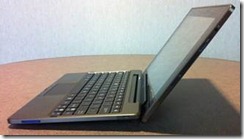
Convertible computers are those that can serve as a standalone media tablet and, when attached to a keyboard, can serve as a notebook. I believe that in 2013, these will be immensely popular. This is aggressive for many reasons, primarily because a convertible PC has never been widely successful. I’d like to share a few reasons why I believe this will be true.
Opposing Logic
First, I’d like to share with you the reasons people have told me convertible PCs won’t be successful.
- “Never worked before”: Convertible PCs have been around for a while now and have sold into targeted vertical markets like healthcare, education and sales, but haven’t sold to wide-spread audiences in mass volumes.
- “Can’t be all things to all people”: This line of logic says that a device cannot be a good tablet and a good clamshell notebook. This makes sense at face value, especially when you look at examples like Heelys. They don’t make great shoes or a decent pair of roller skates you would take to the roller skating rink. Other examples are why all cars aren’t convertibles and all jackets don’t have zip-off sleeves.
- “Too chunky and heavy”: People point to designs with non-detachable displays that are, in fact, thicker compared to a thin a light notebook.
- “Too expensive”: This line of logic says that you will need to pay a major premium to have this functionality.
So those are the reason people have given me for why convertible tablets won’t be successful. Now let’s turn to why I think they will.
Purchase Justification
Everyone who buys something that’s a considered purchase has some justification, emotional or data-driven. Sometimes reality equals testing, sometimes it doesn’t. When I researched consumer PCs in the mid-90’s, consumers said they bought them for “children’s education” but they were used for that only in single digit percentages.
I believe consumers and IT will justify convertibles for similar reasons. They will say:
- “I/my company’s users want a tablet because they are cool, but I need a notebook, but I don’t want both.”
- “I/my company’s users want a tablet and need a notebook, but I/we cannot afford both.”
Buyers will justify the purpose in this way and buy a convertible.
Future Mechanical Designs
How thick and bulky does a convertible PC in the future really need to be? Consider the thickness of a few modern devices:
- Mac Air: 17 mm at its thickest point on an 11.6” display design
- iPad 1: 13.4 mm
- Asus Transformer: 12.98 mm thick, without keyboard
- iPad 2: 8.8 mm at its thickest point
- Apple Wireless Keyboard: ~5 mm thick
I am not a mechanical designer, but it certainly seems possible to have:
- tablet (10mm) +
- keyboard (5mm) +
- torsion control and connector adder (3mm)
- ~18mm total thickness
So conceivably someone could design a convertible that mechanically makes a nice tablet and notebook when connected to the keyboard.
Future Operating Systems, Applications and Multi-Modality
Over the next few years, operating systems and application environments will undergo dramatic changes and will most likely impact the uptake of convertibles. Let’s take a look at a few signposts:
- Windows 8: At D9, I personally witnessed the new OS incorporating elements of tablet and notebook in the same platform. Yes, the multi-modality created some discussion and controversy, but it is coming.
- Android: My Asus Transformer, albeit having Honeycomb OS challenges, delivers a decent tablet and clamshell experience today. It can only get better from there, right? Judging from some of the news to come out at Google I/O in May, Ice Cream Sandwich will incorporate elements of tablets and clamshells. Imagine a single .apk for phone, tablet, and clamshell device.
- Apple: If OS/X and iOS share a common kernel, is it impossible to imagine unification on a convertible device? I certainly noticed many common UI elements between Lion and iOS 5, did you? Check out Lion’s Full-Screen Apps, Launchpad, Preview, and Multi-Touch Gestures. This looks familiar to any iPad user.
Improved GPU Capability
Today on my Asus Transformer, when I toggle between tablet mode and clamshell mode, I get the same exact UI. But I could do a lot more, especially when I have a mouse attached. The mouse is a precision HCI device providing the ability to control more data and information.
Here is the interaction I really want:
- Clamshell mode (tablet + keyboard): Fonts, bars, and buttons get smaller and more appropriate for a precision UI environment.
- Tablet mode: Fonts, bars, scale larger for an imprecise, finger-driven UI environment
This would not only take awesome programming, but improved GPUs for tablets, which we know is on its way from AMD and others.
Additionally, we cannot forget about the emerging OpenCL standard supported by AMD, ARM, Intel and Nvidia which will leverage the GPU to drive compute cycles which are today executed on the CPU. With future GPUs better leveraging OpenCL and their corresponding apps, this will enable a much better experience on convertibles.
Conclusion
Convertible PCs have been around for years, but never took off in big volumes across mass markets because they didn’t deliver on the promise of making a good tablet and a good clamshell. Between now and 2013, enhancements in design, operating environments, improvement in GPU capability combined with buyer’s purchase justification will make convertibles extremely popular.
Follow @PatrickMoorhead on Twitter and on Google+.


